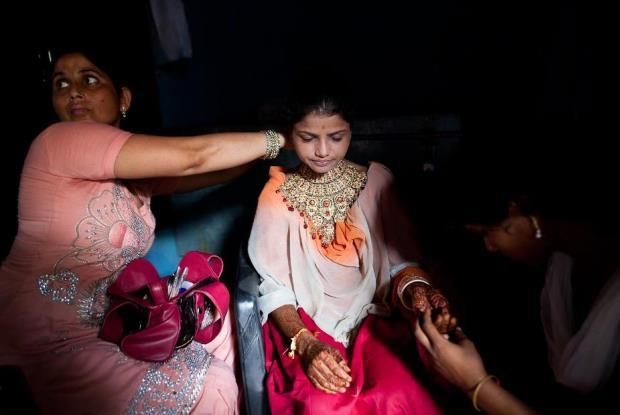Where We Work
See our interactive map


Currently, almost half of the world’s population is under the age of 25. That represents three billion adolescents who have their full lives ahead of them. A strong education and economic opportunities can help adolescents plan productive and fulfilling futures, but without access to reproductive health services, their plans could be interrupted by unintended pregnancy. Unfortunately, many adolescents currently live in places that restrict access to these services for young people. And in some cases, these adolescents are married. Some communities view early marriage as a protective factor for a young woman’s sexual health and safety; however, early marriage is a risk factor for many health and social issues. Often married to older men, these young women typically have little to no negotiating power in their relationships, resulting in unsafe sex and adolescent pregnancies.
This year, World Population Day focuses on adolescent pregnancy and the health risks that girls face when they become pregnant too young. We often view teen pregnancy as something shocking, something that happened to a young girl happily living her life in high school who didn’t really understand the consequences, like the girls portrayed, in the US, on Teen Mom or 16 and Pregnant. But did you know that 90% of pregnant adolescents in developing countries are married, and that fulfilling the need for modern family planning among these adolescents would prevent 7.4 million unintended pregnancies each year?
Children born to mothers under the age of 20 are significantly more likely to die than those born to mothers aged 20-29, and maternal mortality is the leading cause of death in developing countries for female adolescents ages 15-19. Early marriage puts adolescents at risk for HIV, domestic violence, and complications from childbirth including obstetric fistula.
There are clear dangers associated with early marriage. Ensuring communities, families, and adolescents understand the risks of early marriage and protecting the rights of adolescent girls to choose to prevent pregnancy until they are physically and emotionally ready to have a child are vital components of adolescent health programs.As a global health fellow at IntraHealth International, I have seen what youth are able to do when they are able to take control of their fertility. Inspiring examples include young people participating in Beat Making Labs in Senegal and Ethiopia, youth engagement in social media campaigns to champion family planning, and young people starting their training to become health workers to spread vital health messages to their communities. Seeing these results from engaged youth makes programs to prevent unplanned pregnancies in adolescents even more pressing.
Reaching Girls: The Role of Health Workers
Another inspiring example comes from India. In the country’s Jharkhand state, IntraHealth’s Vistaar Project worked to delay the age of marriage for young girls to prevent some of the health risks associated with early marriage. At the request of the Government of Jharkhand, IntraHealth engaged with communities and local health officials to strengthen their adolescent health programs.The project worked with state and district officials to identify specific interventions and innovative approaches that would appeal to youth. The Vistaar Project worked with government officials and sensitized them to the dangers of early marriage, stressing the risk of death associated with adolescent pregnancies.
The project developed a life skills curriculum for adolescent girls who are currently in school, but often the girls who need the education about these threats have already been pulled out of school—or never had the chance to attend. This is where health workers become a vital part of the equation.
IntraHealth worked alongside the Government of Jharkhand to build the capacity of Anganwadi workers and their supervisors in interpersonal communication. Anganwadi workers are frontline health workers who connect communities to organized health care and provide supplementary nutrition, antenatal and postnatal care, and health education. Talking with families about adolescent pregnancy and early marriage can be difficult. The program was designed to improve communication skills in order to make it easier and more effective for Anganwadi workers to talk with adolescents and their parents about the dangers of adolescent pregnancy and early marriage. These frontline health workers used health weeks, nutrition days, and home visits to discuss these and other important health issues with families. Contraceptive education was a key element in all of these activities, and the project’s endline survey showed a significant increase in girls’ knowledge of family planning methods. Adolescents also had access to adolescent-friendly clinics where they could feel safe attending and speaking with providers. These interventions to protect adolescent girls’ health are working. At the end of the project, results indicated that fewer adolescent girls were marrying and knowledge and attitudes around early marriage had changed. You can read all the details here, where results point to girls in Jharkhand engaging more actively in planning their own futures. This is just one example of how well-planned and well-implemented interventions can help mitigate the dangers of adolescent pregnancy. Other projects led by IntraHealth and other international and local organizations are involving youth in innovative advocacy techniques, social media campaigns, and peer education programs.
With the increased support of these projects, and as adolescents make their voices and concerns heard around the world, girls will be able to shape their own dreams for the future and ensure the pregnancies they do go on to have are wanted and planned.
Get the latest updates from the blog and eNews




